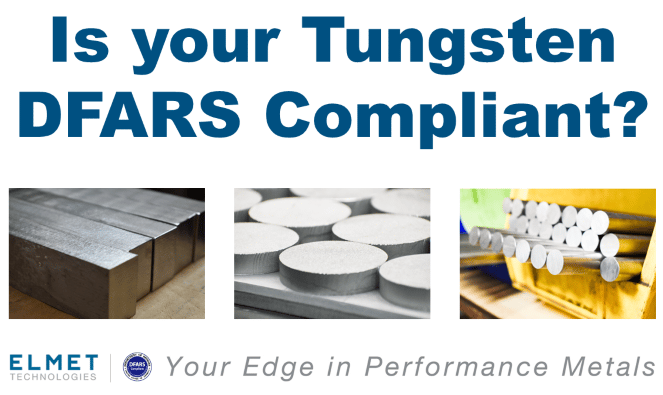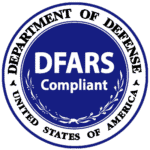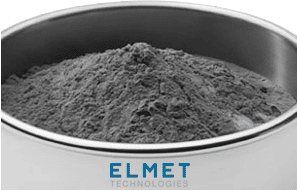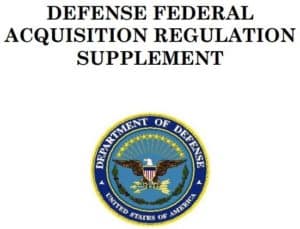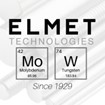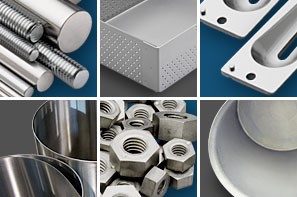When it comes to sourcing tungsten materials, such as tungsten heavy alloy, you’ll want to make sure the materials are manufactured by a DFARS compliant tungsten supplier.
DFARS is a set of regulations, administered by the Department of Defense (DoD). As a well-known set of rules and restrictions on foreign sources of supply, its purpose is to bolster the domestic US industrial base.
These rules also protect the industrial base from becoming too reliant on foreign sources of supply. In short, the phrase “DFARS compliant” indicates that manufacturing of certain materials, such as specialty metals (tungsten and others), are from DoD-approved, domestic sources or NATO countries.
Specific to tungsten and its related alloys, recent Department of Defense rules under DFARS place restrictions on the acquisition of tungsten powder and other tungsten products from certain countries. These restrictions also apply to tungsten heavy alloy materials and products.
At Elmet Technologies, we support the DoD and its prime contractors with US-produced tungsten in compliance with the new DFARS. In doing so, we would like to inform and remind all prospective and existing customers about the latest conditions needed for DFARS compliant tungsten.
Here, we’ll walk you through the basics of DFARS compliance.
DFARS Regulations: Tungsten & Other Specialty Metals
While the full scope of DFARS is much larger, we’ll focus on how it impacts the acquisition of certain specialty metals, such as tungsten. It is important to note that these rules also now apply to tungsten alloys. Note, however, that a supplier certifying tungsten products only to Specialty Metals DFARS does NOT mean the tungsten meets the latest regulation for tungsten used in DoD programs. Certifications must state compliance to 252.225-7052 – Restriction on Acquisition of Certain Magnets and Tungsten.
For DFARS compliant tungsten, supplier certifications must state compliance to 252.225-7052 – Restriction on Acquistion of Certain Magnets and Tungsten. If suppliers are not stating compliance to 252.225-7052, that tungsten is not fully DFARS compliant for use in Department of Defense programs.
252.225-7008 – Restriction on Acquisition of Specialty Metals.
As prescribed in 225.7003-5 (a)(1), use the following clause:
RESTRICTION ON ACQUISITION OF SPECIALTY METALS (MAR 2013)
(a) Definitions. As used in this clause—
“Alloy” means a metal consisting of a mixture of a basic metallic element and one or more metallic, or non-metallic, alloying elements.
(i) For alloys named by a single metallic element (e.g., titanium alloy), it means that the alloy contains 50 percent or more of the named metal (by mass).
(ii) If two metals are specified in the name (e.g, nickel-iron alloy), those metals are the two predominant elements in the alloy, and together they constitute 50 percent or more of the alloy (by mass).
“Produce” means—
(i) Atomization;
(ii) Sputtering; or
(iii) Final consolidation of non-melt derived metal powders.
“Specialty metal” means—
(i) Steel—
(A) With a maximum alloy content exceeding one or more of the following limits: manganese, 1.65 percent; silicon, 0.60 percent; or copper, 0.60 percent; or
(B) Containing more than 0.25 percent of any of the following elements: aluminum, chromium, cobalt, molybdenum, nickel, niobium (columbium), titanium, tungsten, or vanadium;
(ii) Metal alloys consisting of—
(A) Nickel or iron-nickel alloys that contain a total of alloying metals other than nickel and iron in excess of 10 percent; or
(B) Cobalt alloys that contain a total of alloying metals other than cobalt and iron in excess of 10 percent;
(iii) Titanium and titanium alloys; or
(iv) Zirconium and zirconium alloys.
“Steel” means an iron alloy that includes between .02 and 2 percent carbon and may include other elements.
(b) Any specialty metal delivered under this contract shall be melted or produced in the United States or its outlying areas.
252.225-7009 – Restriction on Acquisition of Certain Articles Containing Specialty Metals.
As prescribed in 225.7003-5(a)(2), use the following clause:
Restriction on Acquisition of Certain Articles Containing Specialty Metals (DEC 2019)
(a) Definitions. As used in this clause –
“Alloy” means a metal consisting of a mixture of a basic metallic element and one or more metallic, or non-metallic, alloying elements.
(i) For alloys named by a single metallic element (e.g., titanium alloy), it means that the alloy contains 50 percent or more of the named metal (by mass).
(ii) If two metals are specified in the name (e.g., nickel-iron alloy), those metals are the two predominant elements in the alloy, and together they constitute 50 percent or more of the alloy (by mass).
“Assembly” means an item forming a portion of a system or subsystem that—
(i) Can be provisioned and replaced as an entity; and
(ii) Incorporates multiple, replaceable parts.
“Commercial derivative military article” means an item acquired by the Department of Defense that is or will be produced using the same production facilities, a common supply chain, and the same or similar production processes that are used for the production of articles predominantly used by the general public or by nongovernmental entities for purposes other than governmental purposes.
“Commercially available off-the-shelf item”—
(i) Means any item of supply that is –
(A) A commercial item (as defined in paragraph (1) of the definition of “commercial item” in section 2.101 of the Federal Acquisition Regulation);
(B) Sold in substantial quantities in the commercial marketplace; and
(C) Offered to the Government, under this contract or a subcontract at any tier, without modification, in the same form in which it is sold in the commercial marketplace; and
(ii) Does not include bulk cargo, as defined in 46 U.S.C. 40102(4), such as agricultural products and petroleum products.
“Component” means any item supplied to the Government as part of an end item or of another component.
“Electronic component” means an item that operates by controlling the flow of electrons or other electrically charged particles in circuits, using interconnections of electrical devices such as resistors, inductors, capacitors, diodes, switches, transistors, or integrated circuits. The term does not include structural or mechanical parts of an assembly containing an electronic component, and does not include any high performance magnets that may be used in the electronic component.
“End item” means the final production product when assembled or completed and ready for delivery under a line item of this contract.
“High performance magnet” means a permanent magnet that obtains a majority of its magnetic properties from rare earth metals (such as samarium).
“Produce” means—
(i) Atomization;
(ii) Sputtering; or
(iii) Final consolidation of non-melt derived metal powders.
“Qualifying country” means any country listed in the definition of “Qualifying country” at 225.003 of the Defense Federal Acquisition Regulation Supplement (DFARS).
“Specialty metal” means—
(i) Steel—
(A) With a maximum alloy content exceeding one or more of the following limits: manganese, 1.65 percent; silicon, 0.60 percent; or copper, 0.60 percent; or
(B) Containing more than 0.25 percent of any of the following elements: aluminum, chromium, cobalt, molybdenum, nickel, niobium (columbium), titanium, tungsten, or vanadium;
(ii) Metal alloys consisting of—
(A) Nickel or iron-nickel alloys that contain a total of alloying metals other than nickel and iron in excess of 10 percent; or
(B) Cobalt alloys that contain a total of alloying metals other than cobalt and iron in excess of 10 percent;
(iii) Titanium and titanium alloys; or
(iv) Zirconium and zirconium alloys.
“Steel” means an iron alloy that includes between .02 and 2 percent carbon and may include other elements.
“Subsystem” means a functional grouping of items that combine to perform a major function within an end item, such as electrical power, attitude control, and propulsion.
(b) Restriction.Except as provided in paragraph (c) of this clause, any specialty metals incorporated in items delivered under this contract shall be melted or produced in the United States, its outlying areas, or a qualifying country.
(c) Exceptions.The restriction in paragraph (b) of this clause does not apply to—
(1) Electronic components.
(2)(i) Commercially available off-the-shelf (COTS) items, other than—
(A) Specialty metal mill products, such as bar, billet, slab, wire, plate, or sheet, that have not been incorporated into COTS end items, subsystems, assemblies, or components;
(B) Forgings or castings of specialty metals, unless the forgings or castings are incorporated into COTS end items, subsystems, or assemblies;
(C) Commercially available high performance magnets that contain specialty metal, unless such high performance magnets are incorporated into COTS end items or subsystems; and
(D) COTS fasteners, unless—
(1) The fasteners are incorporated into COTS end items, subsystems, assemblies, or components; or
(2) The fasteners qualify for the commercial item exception in paragraph (c)(3) of this clause.
(ii) A COTS item is considered to be “without modification” if it is not modified prior to contractual acceptance by the next higher tier in the supply chain.
(A) Specialty metals in a COTS item that was accepted without modification by the next higher tier are excepted from the restriction in paragraph (b) of this clause, and remain excepted, even if a piece of the COTS item subsequently is removed (e.g., the end is removed from a COTS screw or an extra hole is drilled in a COTS bracket).
(B) Specialty metals that were not contained in a COTS item upon acceptance, but are added to the COTS item after acceptance, are subject to the restriction in paragraph (b) of this clause (e.g., a special reinforced handle made of specialty metal is added to a COTS item).
(C) If two or more COTS items are combined in such a way that the resultant item is not a COTS item, only the specialty metals involved in joining the COTS items together are subject to the restriction in paragraph (b) of this clause (e.g., a COTS aircraft is outfitted with a COTS engine that is not the COTS engine normally provided with the aircraft).
(D) For COTS items that are normally sold in the commercial marketplace with various options, items that include such options are also COTS items. However, if a COTS item is offered to the Government with an option that is not normally offered in the commercial marketplace, that option is subject to the restriction in paragraph (b) of this clause (e.g. – An aircraft is normally sold to the public with an option for installation kits. The Department of Defense requests a military-unique kit. The aircraft is still a COTS item, but the military-unique kit is not a COTS item and must comply with the restriction in paragraph (b) of this clause unless another exception applies).
(3) Fasteners that are commercial items, if the manufacturer of the fasteners certifies it will purchase, during the relevant calendar year, an amount of domestically melted or produced specialty metal, in the required form, for use in the production of fasteners for sale to the Department of Defense and other customers, that is not less than 50 percent of the total amount of the specialty metal that it will purchase to carry out the production of such fasteners for all customers.
(4) Items manufactured in a qualifying country.
(5) Specialty metals for which the Government has determined in accordance with DFARS 225.7003-3 that specialty metal melted or produced in the United States, its outlying areas, or a qualifying country cannot be acquired as and when needed in—
(i) A satisfactory quality;
(ii) A sufficient quantity; and
(iii) The required form. In accordance with 10 U.S.C. 2533b(m)(4), the term “required form” in this clause refers to the form of the mill product, such as bar, billet, wire, slab, plate, or sheet, in the grade appropriate for the production of a finished end item to be delivered to the Government under this contract; or a finished component assembled into an end item to be delivered to the Government under this contract.
(6) End items containing a minimal amount of otherwise noncompliant specialty metals (i.e., specialty metals not melted or produced in the United States, an outlying area, or a qualifying country, that are not covered by one of the other exceptions in this paragraph (c)), if the total weight of such noncompliant metals does not exceed 2 percent of the total weight of all specialty metals in the end item, as estimated in good faith by the Contractor. This exception does not apply to high performance magnets containing specialty metals.
(d) Compliance for commercial derivative military articles.
(1) As an alternative to the compliance required in paragraph (b) of this clause, the Contractor may purchase an amount of domestically melted or produced specialty metals in the required form, for use during the period of contract performance in the production of the commercial derivative military article and the related commercial article, if—
(i) The Contracting Officer has notified the Contractor of the items to be delivered under this contract that have been determined by the Government to meet the definition of “commercial derivative military article”; and
(ii) For each item that has been determined by the Government to meet the definition of “commercial derivative military article,” the Contractor has certified, as specified in the provision of the solicitation entitled “Commercial
Derivative Military Article—Specialty Metals Compliance Certificate” (DFARS 252.225-7010 ), that the Contractor and its subcontractor(s) will enter into a contractual agreement or agreements to purchase an amount of domestically melted or produced specialty metal in the required form, for use during the period of contract performance in the production of each commercial derivative military article and the related commercial article, that is not less than the Contractor’s good faith estimate of the greater of—
(A) An amount equivalent to 120 percent of the amount of specialty metal that is required to carry out the production of the commercial derivative military article (including the work performed under each subcontract); or
(B) An amount equivalent to 50 percent of the amount of specialty metal that will be purchased by the Contractor and its subcontractors for use during such period in the production of the commercial derivative military article and the related commercial article.
(2) For the purposes of this alternative, the amount of specialty metal that is required to carry out production of the commercial derivative military article includes specialty metal contained in any item, including COTS items.
(e) Subcontracts.
(1) The Contractor shall exclude and reserve paragraph (d) and this paragraph (e)(1) when flowing down this clause to subcontracts.
(2) The Contractor shall insert paragraphs (a) through (c) and this paragraph (e)(2) of this clause in subcontracts, including subcontracts for commercial items, that are for items containing specialty metals to ensure compliance of the end products that the Contractor will deliver to the Government. When inserting this clause in subcontracts, the Contractor shall—
(i) Modify paragraph (c)(6) of this clause only as necessary to facilitate management of the minimal content exception at the prime contract level. The minimal content exception does not apply to specialty metals contained in high-performance magnets; and
(ii) Not further alter the clause other than to identify the appropriate parties.
252.225-7052 – Restriction on Acquisition of Certain Magnets and Tungsten.
As prescribed in 225.7018-5 , use the following clause:
Restriction on the Acquisition of Certain Magnets, Tantalum, and Tungsten (AUG 2022)
(a) Definitions. As used in this clause—
“Assembly” means an item forming a portion of a system or subsystem that—
(1) Can be provisioned and replaced as an entity; and
(2) Incorporates multiple, replaceable parts.
“Commercially available off-the-shelf item”—
(1) Means any item of supply that is—
(i) A commercial item (as defined in paragraph (1) of the definition of “commercial item” in section 2.101 of the Federal Acquisition Regulation);
(ii) Sold in substantial quantities in the commercial marketplace; and
(iii) Offered to the Government, under this contract or a subcontract at any tier, without modification, in the same form in which it is sold in the commercial marketplace; and
(2) Does not include bulk cargo, as defined in 46 U.S.C. 40102(4), such as agricultural products and petroleum products.
“Component” means any item supplied to the Government as part of an end item or of another component.
“Covered country” means—
(1) The Democratic People’s Republic of North Korea;
(2) The People’s Republic of China;
(3) The Russian Federation; or
(4) The Islamic Republic of Iran.
“Covered material” means—
(1) Samarium-cobalt magnets;
(2) Neodymium-iron-boron magnets;
(3) Tantalum metals and alloys;
( 4 ) Tungsten metal powder; and
( 5 ) Tungsten heavy alloy or any finished or semi-finished component containing tungsten heavy alloy.
“Electronic device” means an item that operates by controlling the flow of electrons or other electrically charged particles in circuits, using interconnections such as resistors, inductors, capacitors, diodes, switches, transistors, or integrated circuits.
“End item” means the final production product when assembled or completed and ready for delivery under a line item of this contract.
“Subsystem” means a functional grouping of items that combine to perform a major function within an end item, such as electrical power, attitude control, and propulsion.
“Tungsten heavy alloy” means a tungsten base pseudo alloy that—
(1) Meets the specifications of ASTM B777 or SAE-AMS-T-21014 for a particular class of tungsten heavy alloy; or
(2) Contains at least 90 percent tungsten in a matrix of other metals (such as nickel-iron or nickel-copper) and has density of at least 16.5 g/cm3).
(b) Restriction.
(1) Except as provided in paragraph (c) of this clause, the Contractor shall not deliver under this contract any covered material melted or produced in any covered country, or any end item, manufactured in any covered country, that contains a covered material (10 U.S.C. 2533c).
(2)(i) For samarium-cobalt magnets and neodymium iron-boron magnets, this restriction includes—
(A) Melting samarium with cobalt to produce the samarium-cobalt alloy or melting neodymium with iron and boron to produce the neodymium-iron-boron alloy; and
(B) All subsequent phases of production of the magnets, such as powder formation, pressing, sintering or bonding, and magnetization.
(ii) The restriction on melting and producing of samarium-cobalt magnets is in addition to any applicable restrictions on melting of specialty metals if the clause at 252.225-7009 , Restriction on Acquisition of Certain Articles Containing Specialty Metals, is included in the contract.
(3) For production of tantalum metals of any kind and alloys, this restriction includes the reduction or melting of any form of tantalum to create tantalum metal including unwrought, powder, mill products, and alloys. The restriction also covers all subsequent phases of production of tantalum metals and alloys.
(4) For production of tungsten metal powder and tungsten heavy alloy, this restriction includes–
(i) Atomization;
(ii) Calcination and reduction into powder;
(iii) Final consolidation of non-melt derived metal powders; and
(iv) All subsequent phases of production of tungsten metal powder, tungsten heavy alloy, or any finished or semi-finished component containing tungsten heavy alloy.
(c) Exceptions. This clause does not apply—
(1) To an end item containing a covered material that is—
(i) A commercially available off-the-shelf item, other than—
(A) A commercially available off-the-shelf item that is 50 percent or more tungsten by weight; or
(B) A tantalum metal, tantalum alloy, or tungsten heavy alloy, such as bar, billet, slab, wire, cube, sphere, block, blank, plate, or sheet, that has not been incorporated into an end item, subsystem, assembly, or component;
(ii) An electronic device, unless otherwise specified in the contract; or
(iii) A neodymium-iron-boron magnet manufactured from recycled material if the milling of the recycled material and sintering of the final magnet takes place in the United States.
(2) If the authorized agency official concerned has made a nonavailability determination, in accordance with section 225.7018-4 of the Defense Federal Acquisition Regulation Supplement, that compliant covered materials of satisfactory quality and quantity, in the required form, cannot be procured as and when needed at a reasonable price.
(i) For tantalum metal, tantalum alloy, or tungsten heavy alloy, the term “required form” refers to the form of the mill product, such as bar, billet, wire, slab, plate, or sheet, in the grade appropriate for the production of a finished end item to be delivered to the Government under this contract; or a finished component assembled into an end item to be delivered to the Government under the contract.(ii) For samarium-cobalt magnets or neodymium-iron-boron magnets, the term “required form” refers to the form and properties of the magnets.
(d) Subcontracts. The Contractor shall insert the substance of this clause, including this paragraph (d), in subcontracts and other contractual instruments that are for items containing a covered material, including subcontracts and other contractual instruments for commercial items, unless an exception in paragraph (c) of this clause applies. The Contractor shall not alter this clause other than to identify the appropriate parties.
252.225-7052 Restriction on the Acquisition of Certain Magnets, Tantalum, and Tungsten
252.225-7052 Restriction on the Acquisition
of Certain Magnets, Tantalum, and Tungsten.
As prescribed in 225.7018-5 , use the following clause:
Restriction on the Acquisition of Certain Magnets, Tantalum, and Tungsten (MAY 2024)
(a) Definitions. As used in this clause—
“Assembly” means an item forming a portion of a system or subsystem that—
(1) Can be provisioned and replaced as an entity; and
(2) Incorporates multiple, replaceable parts.
“Commercially available off-the-shelf item”—
(1) Means any item of supply that is—
(i) A commercial product (as defined in paragraph (1) of the definition of “commercial product” in
section 2.101 of the Federal Acquisition Regulation);
(ii) Sold in substantial quantities in the commercial marketplace; and
(iii) Offered to the Government, under this contract or a subcontract at any tier, without
modification, in the same form in which it is sold in the commercial marketplace; and
(2) Does not include bulk cargo, as defined in 46 U.S.C. 40102(4), such as agricultural products and
petroleum products.
“Component” means any item supplied to the Government as part of an end item or of another
component.
“Covered country” means—
(1) The Democratic People’s Republic of North Korea;
(2) The People’s Republic of China;
(3) The Russian Federation; or
(4) The Islamic Republic of Iran.
“Covered material” means—
(1) Samarium-cobalt magnets;
(2) Neodymium-iron-boron magnets;
(3) Tantalum metals and alloys;
( 4 ) Tungsten metal powder; and
( 5 ) Tungsten heavy alloy or any finished or semi-finished component containing tungsten heavy
alloy.
“Electronic device” means an item that operates by controlling the flow of electrons or other
electrically charged particles in circuits, using interconnections such as resistors, inductors,
capacitors, diodes, switches, transistors, or integrated circuits.
“End item” means the final production product when assembled or completed and ready for delivery
under a line item of this contract.
“Subsystem” means a functional grouping of items that combine to perform a major function within
an end item, such as electrical power, attitude control, and propulsion.
“Tungsten heavy alloy” means a tungsten base pseudo alloy that—
(1) Meets the specifications of ASTM B777 or SAE-AMS-T-21014 for a particular class of tungsten
heavy alloy; or
(2) Contains at least 90 percent tungsten in a matrix of other metals (such as nickel-iron or nickelcopper)
and has density of at least 16.5 g/cm3).
(b) Restriction.
(1) Except as provided in paragraph (c) of this clause,—
(i) Effective through December 31, 2026, the Contractor shall not deliver under this contract any
covered material melted or produced in any covered country, or any end item, manufactured in any
covered country, that contains a covered material (10 U.S.C. 4872).
(ii) Effective January 1, 2027, the Contractor shall not deliver under this contract any covered
material mined, refined, separated, melted, or produced in any covered country, or any end item,
manufactured in any covered country, that contains a covered material (section 854, Pub. L. 118-31;
10 U.S.C. 4872).
(2)(i)(A) Effective through December 31, 2026, for samarium-cobalt magnets and neodymium-ironboron
magnets, this restriction includes—
( 1 ) Melting samarium with cobalt to produce the samarium-cobalt alloy or melting neodymium with
iron and boron to produce the neodymium-iron-boron alloy; and
( 2 ) All subsequent phases of production of the magnets, such as powder formation, pressing,
sintering or bonding, and magnetization.
(B) Effective January 1, 2027, for samarium-cobalt magnets this restriction includes the entire
supply chain from mining or production of a cobalt and samarium ore or feedstock, including
recycled material, through production of finished magnets.
(ii) The restriction on melting and producing of samarium-cobalt magnets is in addition to any
applicable restrictions on melting of specialty metals if the clause at 252.225-7009 , Restriction on
Acquisition of Certain Articles Containing Specialty Metals, is included in the contract.
(3) Effective January 1, 2027, for neodymium-iron-boron magnets, this restriction includes the entire
supply chain from mining of neodymium, iron, and boron through production of finished magnets.
(4)(i) Effective through December 31, 2026, for production of tantalum metals of any kind and alloys,
this restriction includes the reduction or melting of any form of tantalum to create tantalum metal
including unwrought, powder, mill products, and alloys. The restriction also covers all subsequent
phases of production of tantalum metals and alloys.
(ii) Effective January 1, 2027, for production of tantalum metals of any kind and alloys, this
restriction includes mining or production of a tantalum ore or feedstock, including recycled material,
through production of metals of any kind and alloys.
(5)(i) Effective through December 31, 2026, for production of tungsten metal powder and tungsten
heavy alloy, this restriction includes–
(A) Atomization;
(B) Calcination and reduction into powder;
(C) Final consolidation of non-melt derived metal powders; and
(D) All subsequent phases of production of tungsten metal powder, tungsten heavy alloy, or any
finished or semi-finished component containing tungsten heavy alloy.
(ii) Effective January 1, 2027, for production of tungsten metal powder, tungsten heavy alloy, or any
finished or semi-finished component containing tungsten heavy alloy, this restriction includes mining
or production of a tungsten ore or feedstock, including recycled material, through production of
tungsten metal powders, tungsten heavy alloy, or any finished or semi-finished component
containing tungsten heavy alloy.
(c) Exceptions. This clause does not apply—
(1) To an end item containing a covered material that is—
(i) A commercially available off-the-shelf item, other than—
(A) A commercially available off-the-shelf item that is—
(1) 50 percent or more tungsten by weight effective through December 31, 2026; or
(2) 50 percent or more covered material by weight effective January 1, 2027;
(B) Effective through December 31, 2026, a tantalum metal, tantalum alloy, or tungsten heavy alloy,
such as bar, billet, slab, wire, cube, sphere, block, blank, plate, or sheet, that has not been
incorporated into an end item, subsystem, assembly, or component;
(ii) Effective January 1, 2027, a covered material that is a mill product, such as bar, billet, slab, wire,
cube, sphere, block, blank, plate, or sheet, that has not been incorporated into an end item,
subsystem, assembly, or component;
(iii)An electronic device, unless otherwise specified in the contract; or
(iv) A neodymium-iron-boron magnet manufactured from recycled material if the milling of the
recycled material and sintering of the final magnet takes place in the United States.
(2) If the authorized agency official concerned has made a nonavailability determination, in
accordance with section 225.7018-4 of the Defense Federal Acquisition Regulation Supplement, that
compliant covered materials of satisfactory quality and quantity, in the required form, cannot be
procured as and when needed at a reasonable price.
(i) For tantalum metal, tantalum alloy, or tungsten heavy alloy, the term “required form” refers to
the form of the mill product, such as bar, billet, wire, slab, plate, or sheet, in the grade appropriate
for the production of a finished end item to be delivered to the Government under this contract; or a
finished component assembled into an end item to be delivered to the Government under the
contract.(ii) For samarium-cobalt magnets or neodymium-iron-boron magnets, the term “required
form” refers to the form and properties of the magnets.
(d) Subcontracts. The Contractor shall insert the substance of this clause, including this paragraph
(d), in subcontracts and other contractual instruments that are for items containing a covered
material, including subcontracts and other contractual instruments for commercial products, unless
an exception in paragraph (c) of this clause applies. The Contractor shall not alter this clause other
than to identify the appropriate parties.
(End of clause)
Parent topic: 252.225 RESERVED
FAQs and Summary
Below, explore some of the common questions regarding DFARS compliant tungsten.
What is DFARS an acronym for?
DFARS is an acronym that stands for The Defense Federal Acquisition Regulation Supplement (DFARS).
Who published DFARS?
The Department of Defense (DoD).
How does DFARS apply to acquiring tungsten heavy alloy and other specialty tungsten materials?
Effective December 2019, the Department of Defense (DoD) finalized and fully implemented a rule change and new restrictions on the acquisition of tungsten powder and products from certain countries. The materials covered by the 2019 rule change include: samarium-cobalt magnets, neodymium-iron-boron magnets, tungsten metal powder, tungsten heavy alloy, and any material, finished or semi-finished containing tungsten heavy alloy that is either melted or produced in Russia, Iran, China, and/or North Korea.
Learn more about the 2019 Department of Defense rule changes involving DFARS compliant tungsten, here.
Which DFARS restrictions or clauses should you consider when procuring tungsten?
When procuring tungsten, you’ll want to be familiar of the following restrictions and clauses:
- 252.225-7008: Restriction on Acquisition of Specialty Metals.
- 252.225-7009: Restriction on Acquisition of Certain Articles Containing Specialty Metals.
- 252.225-7052: Restriction on the Acquisition of Certain Magnets and Tungsten.
It is especially critical to understand adherence and compliance to 252.225-7052 when procuring DFARS compliant tungsten.
Which standards should you consider when procuring tungsten heavy alloys?
When procuring tungsten heavy alloy materials, you’ll want to consider the following industry specifications:
- ASTM B777
- AMS 7725
- SAE-AMS-T-21014
- MIL-T-21014D
What is ASTM B777 and AMS 7725?
ASTM B777 and AMS 7725 are standards, specifications, and definitions for tungsten heavy alloys.
Learn more about these specifications in our ASTM B777 – AMS 7725 Overview page.
What is SAE-AMS-T-21014 and MIL-T-21014D?
These specifications cover the requirements for the four classes of machinable, high-density tungsten metal base produced by consolidation of metal powder mixtures whose composition is mainly tungsten.
Where can I learn more about DFARS?
The best place to learn about DFARS is the Acquistion.GOV website.
What does it mean when material suppliers are partially certifying material is DFARS compliant?
This indicates they can certify to 252.225-7008 and 252.225-7009. They cannot certify to DFAR 252.225-7052 if they are getting material from outside the United States.
Where can I learn more about DFARS as it relates to tungsten?
Feel free to reach out to the experts here at Elmet Technologies. We’re happy to educate you on DFARS compliance, or help you explore our expansive line of DFARS compliant tungsten materials and products.
In addition, you may want to reference an earlier blog post of ours, Department of Defense Finalizes Its Restrictions on Foreign Acquisition of Tungsten Powder, and Products.
Our DFARS Compliant Tungsten Products
Elmet Technologies DFARS Compliant Tungsten products includes a range of blocks, rods, plate, sheet, cubes, spheres, and shaped parts. Elmet manufactures all USA made materials at our fully-integrated facility in Lewiston, Maine. We often precision machine our parts for use as ballast weights, radiation shields, boring bars, ordnance components, and other applications. Our specialty is applications that require high density and good ductility.
Elmet’s refractory metals expertise covers a wide range of pure metals (including tungsten and molybdenum). In addition, associated alloys, such as:
- Tungsten Heavy Alloy (WHA)
- Molybdenum-Tantalum (MoTa)
- Potassium-Doped Tungsten (WK)
- Lanthanated Molybdenum (MoLa)
- Potassium-Doped Molybdenum (HCT)
- Titanium, Zirconium, Molybdenum (TZM)
Check out Elmet’s tungsten products.
Check out Elmet’s tungsten heavy alloy products.
Other questions? Ask us!
Let Elmet Technologies answer all your questions about DFARS compliant tungsten materials and products.

